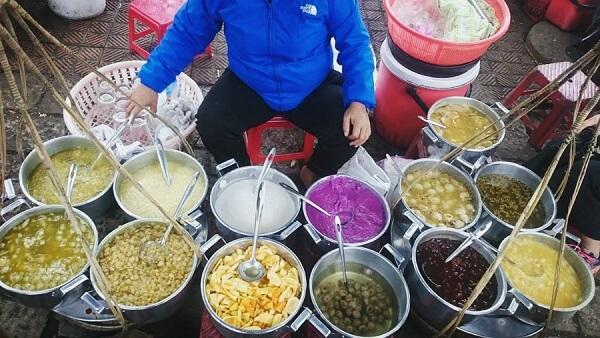Born and raised in the central region of Vietnam, we are all too familiar with the heat that makes this region’s title every summer. Due to global warming, Hoi An, as well as other cities in central Vietnam, from April, temperature is always no lower than 38 degrees Celsius. In these freaking hot days, skipping all boring steaming hot dishes such as rice, noodles or bread, we tend to long for something quick, chilled and refreshing. A thing that can help us ease the mood of frustration on muggy summer days, which undoubtedly is “Chè“.
What is “Chè“?
It is not exaggerated at all to say “we can eat “Chè” three meals a day” in this kind a hot condition. If you have a chance to visit Hoi An and roam around Hoi An central or Night market, endless signs of “Chè” stalls will definitely catch your eyes. In our childhood, “Chè“ was what most of children in the countryside waited for their mother brought home after they went to the market. It is believed that “Chè“ desserts originated in China, which means a sweet dish filled with syrup. When “Chè” newly introduced to Vietnam, its hearty contents were simply beans and sticky rice with a base of either water or coconut milk, but nowadays, other than beans, people can take advantage of any daily ingredients to make “Chè”, from fruits like bananas, coconuts, jackfruits, longans or lychees to all kinds of jellies, grains, such as millet, corn and even tubers like sweet popatoes, taros, etc…

There are so many different versions of “Chè“. Based on the way to cook, “Chè” is divided into 3 main kinds: “Chè” with more sugary water (Chè nước), “Chè” with viscosity (Chè sánh) and “Chè” in condensed type (Chè đặc). Among them, “Chè nước”, served with ice, is popular in the summer, while “Chè đặc”, served in hot in the winter.

Also, each region in Vietnam has the own way to make “Chè”.
While people in the north focus on every detail in choosing each ingredient and the delicate natural aroma and flavor, the Southern “Chè” tends to be sweeter, eye-catching and seasonal ingredients are often used. Different from those, “Chè” in the Central maybe is the simplest in the way of both cooking and serving. Because of hot weather, locals here are more prone to refreshment, they use most of the cool ingredients which help to cool down inside, such as mung beans, Indian beans, corns, tofu, sweet potatoes, etc,.. “Chè” is also provided with lots of sugary water so that they can enjoy with shaved ice. Nothing is better than a gulp of cool sweet soup added one or two drips of edible banana oil to enhance freshness.
“Chè” is not just a dessert.
Thus, to Vietnamese, “Chè” is not only a dessert, it is also used as a solemn offering during Tet holidays, Mid Autumn festival or familial ceremonies. Each kind of “Chè“ have their own meanings. For example, the sweet rice ball with green bean filling means reunion or the red bean “Chè“ means luck and success.
Nowadays, “Chè” has become an indispensable snack in all the streets. To many Vietnamese generations, this is not just a simple dish but also a soul of Vietnamese cuisine, like “Bánh Mỳ” or “Phở”. Come to Vietnam and don’t miss tasting “Chè“, cause enjoying “Chè” is like experiencing the diversity in culinary culture of each Vietnam ‘s region.
*All photos used in this article are from the internet

